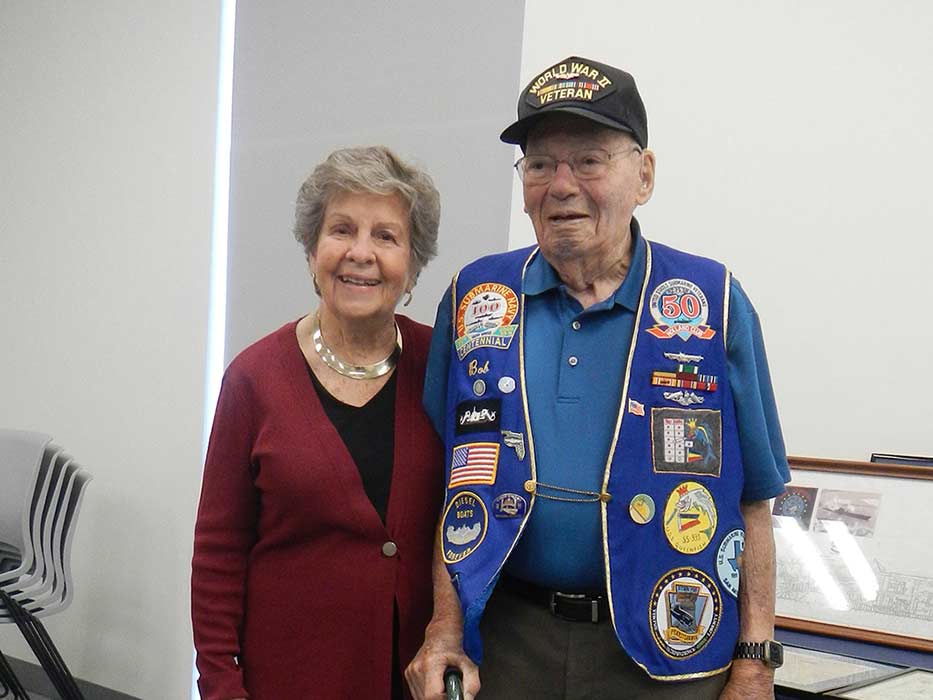
Feature Story and Photos by Linda Charlton
As the veterans of WWll rapidly die off, some organizations are making their best effort to make sure that the veterans’ stories don’t die with them. The National Organization of U.S. Naval Sea Cadets Corps is one of those organizations. The group has launched an initiative to seek out, interview and video record aging sailors, soldiers and airmen telling their personal WWll stories.
The very first interview in that national push happened Saturday morning in Clermont, at a classroom in the second floor of the Clermont police building. The police connection is that the police department is where the Clermont Battalion Sea Cadets hold their regular meetings. With the motto “Greatness Has No Age,” the organization has 400 battalions nationwide for young people age 10-18, and is sponsored by the U.S. Navy. The Clermont Battalion has approximately 40 cadets, “dedicated to preserving the history of service and tradition of the U.S. Navy one story at a time,” according to an official Sea Cadet Corps press release.
That being said, Clermont Battalion Commanding Officer Lt. Gary Schidele made it clear that his cadets want to find and interview WWll veterans from all services, not just from the Navy, the very practical reason being that there are not many WWll vets left.

The official interviewer on Saturday was 18-year-old Sea Cadet Chief Kurt Schindele, son of Gary Schidele. The interviewee was 97-year-old Gunner’s Mate Chief Bob Dickinson, who served multiple patrols in the South Pacific as part of the country’s submarine service. Although the young Schindele did have some prepared questions, the old submariner had a lengthy prepared statement, which pretty much covered the prepared questions.

Dickinson is not the last man standing among the U.S. WWll submariners, but that situation could easily change. He is already the last survivor of his boat’s approximately 80-man crew. He served the bulk of his service on the U.S.S. Queenfish (SS393), 311 feet long and brand new when Dickinson was assigned to it. There were only 16,000 submariners to begin with and they had a fatality rate of right around 20 percent — not near the jaw-dropping 90 percent fatality rate of the German submariners, but deadly enough to make the submarine service an all-volunteer group.
So how did Dickinson become a submariner?
Dickinson was 17 when the United States entered WWll and feeling “guilty” that he could not immediately take part in the war effort. Some months later, after graduating from high school, he and a couple of friends joined the navy. Dickinson had prior service as a volunteer firefighter, so he was quickly assigned stateside as a firefighter. He ended up instructing others on how to fight fires, and spending a lot of time running in and out of fires. That was taking a toll on the young man’s health, so he figured the only way to get out of the fire assignment was to volunteer for submarines.
As he said, “I made the cut.”
One of young Schindele’s follow-up questions to Dickinson was what was the most “heartwarming” experience he had in the Navy. That one had an easy answer, for Dickinson had already given the details.

Submariners were, from time to time, called upon to rescue people from the water. On one occasion the Queenfish was dispatched to search for survivors from an overloaded Japanese prisoner-of-war ship that had gone down. Dickinson was one of the sailors who physically pulled people from the water. They were 19 British and Australian POWs, part of the forced labor crew that had built the Burma Railroad, a project best known to Americans through the 1957 movie “Bridge Over the River Kwai.”
Speaking of the POWS, Dickinson said “We shared clothes, and food, and sleeping quarters and unlimited friendship.”
He added that through the years, the POWs would sometimes come to Queenfish reunions. And he emphasized throughout his presentation on Saturday the intense camaraderie that develops between soldiers and sailors when they are in combat situations.
The answer to Schindele’s follow-up question about Dickinson’s most “heart-pounding” moment involved a torpedo. The Queenfish was in combat, preparing to fire, when a lookout spotted a torpedo coming straight at the boat. The Queenfish got out the way. Really fast.
“That’s the only time I really got scared,” Dickinson said. “When you see a torpedo coming at you, that does a lot to you.”
On a milder note, Dickinson recalled that on the boat’s shakedown cruise, the very first time the boat dived “I was scared just like the other recruits. Eventually, I got used to it and I learned to like it. If you didn’t learn to like it, you didn’t last long in the Navy.”
Dickinson is not done sharing his story. As he said in the beginning of his statement, “I have lived silently, but at the age of 97, I feel it is important to share with the younger generation.”
So Dickinson, together with the older Schindele. has arranged for the old submariner to meet the young cadets in person, and share, and share, and share.

Dickinson was an electrical contractor by trade. He moved to Central Florida years ago to help build Epcot. He and his wife, Jeanne Walton, currently live in Clermont.
Clermont has an active chapter of the United States Submarine Veterans, Inc., and those veterans have a longstanding friendly relationship with the local Sea Cadets. The sub vets actually reached out to the sea cadets to help Dickinson tell his story. Now the sea cadets are seeking out other WWll veterans to interview. As the Schindeles’ report, they are looking to the local veteran’s organization to help locate additional WWll vets.
Any WWll vets who may wish to participate — or family and friends of those veterans…. can contact Kurt Schindele directly at co@clermontbattalion.com.





